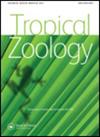中央矮蛙P. centralis Bokermann, 1962的生态位建模和新分布记录(无尾目,细趾蛙科,Leiuperinae)及其分类地位的评述
IF 0.7
4区 生物学
Q4 ZOOLOGY
引用次数: 1
摘要
中央藻分布于南美洲东部的开阔地带。在此,我们对发生记录进行了广泛的审查,并提出了基于生态位建模的潜在分布。为了确认物种鉴定及其分布的分类学地位,我们提供了分析标本的形态学和分子数据。为了实现我们的目标,我们汇编了文献和科学收藏中的可用数据,以及未发表的数据。我们在123个地方发现了中央假单胞菌的记录,其中86个记录尚未公布。因此,有可能将其分布范围扩展到巴西朗多尼亚州,也可以扩展到卡廷加组。Maxent算法提供了一个与这里提出的分布一致的潜在分布模型。结果表明,P.centralis在南美洲的开阔地区(Cerrado、Caatinga和Pantanal)有很大的分布,没有证据表明这是一种物种复杂的情况。本文提出的多重方法结合了来自不同来源的发生数据和分子数据来确认物种鉴定,提供了一致的结果。因此,我们建议在未来的研究中,特别是在广泛分布的物种的情况下,将该框架用作评估物种分布的方案。本文章由计算机程序翻译,如有差异,请以英文原文为准。
Ecological niche modeling and new distribution records of the central dwarf frog P. centralis Bokermann, 1962 (Anura, Leptodactylidae, Leiuperinae) with comments on its taxonomic status
Physalaemus centralis is distributed over open areas of eastern South America. Herein, we perform an extensive review of occurrence records and propose a potential distribution based on ecological niche modeling. In order to confirm species identification, as well taxonomic status along its distribution, we provide morphological and molecular data from analysed specimens. To reach our goals, we compiled data available in the literature and from scientific collections, as well as unpublished data. We identified records of P. centralis in 123 localities, 86 of those records remain unpublished. Consequently, it is possible to extend its range of distribution to the state of Rondônia, Brazil, and also to the Caatinga formation. The Maxent algorithm provided a model of potential distribution consistent with the distribution proposed here. Results indicate that P. centralis has a large distribution associated to open areas of South America (Cerrado, Caatinga and Pantanal), with no evidence that this is a case of species complex. The multiple approach proposed herein, that combines occurrence data from different sources and molecular data to confirm species identification, provided consistent results. Therefore, we recommend that this framework be used as a protocol to assess species distribution in future studies, especially in the case of widely distributed species.
求助全文
通过发布文献求助,成功后即可免费获取论文全文。
去求助
来源期刊

Tropical Zoology
生物-动物学
CiteScore
2.50
自引率
0.00%
发文量
1
审稿时长
>12 weeks
期刊介绍:
Tropical Zoology is an international zoological journal publishing original papers in the field of systematics, biogeography, phylogeny, ecology and conservation of all terrestrial and aquatic animal Phyla from tropical and subtropical areas.
Only papers with new information, high quality and broad interest are considered. Single species description and checklists are not normally accepted. Review papers are welcome. The journal is owned by the Istituto di Ricerca sugli Ecosistemi Terrestri of the Consiglio Nazionale delle Ricerche, Florence, Italy (CNR-IRET) who performs research into the structure and functioning of aquatic and terrestrial ecosystems, focusing in particular on anthropogenic pressure and global change. The knowledge amassed forms the scientific basis for identifying the most appropriate protective and corrective interventions, and provides support for the bodies entrusted with formulating policies for environmental protection and recovery.
 求助内容:
求助内容: 应助结果提醒方式:
应助结果提醒方式:


